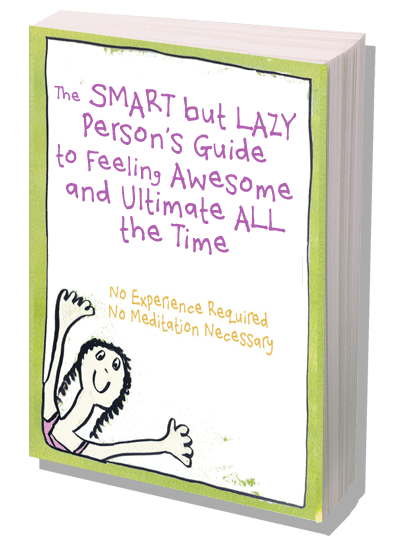LISA ESILE
 Lisa has a master’s degree in science. She regularly guest blogs on Tiny Buddha and has her own popular blog where she writes and draws about how to feel contented even when crappy things happen. Lisa is the author of Reach Your Big Calm: 52 Powerful Messages to Quiet Your Mind and her e-book 7 Secrets Your Mind Doesn’t Want You to Know was downloaded over 12,000 times (it was the first incarnation of Whose Mind Is It Anyway?).
Lisa has a master’s degree in science. She regularly guest blogs on Tiny Buddha and has her own popular blog where she writes and draws about how to feel contented even when crappy things happen. Lisa is the author of Reach Your Big Calm: 52 Powerful Messages to Quiet Your Mind and her e-book 7 Secrets Your Mind Doesn’t Want You to Know was downloaded over 12,000 times (it was the first incarnation of Whose Mind Is It Anyway?).
As a young adult Lisa spent 5 years in bed with chronic fatigue syndrome. It was a pivotal moment. A catalyst through which Lisa learned to heal herself physically and emotionally as well.
“There’s nothing like having everything you’d based your self esteem on go away to teach you some deep life lessons. I honestly don’t know if you can learn them without going through upheaval of some sort.”
In 2009, scared that her C.F.S. was returning, she spent a day doing nothing and being silent, as a way to change old habits and heal. What started as one day turned into three, then into a month, then eventually into what Lisa calls ‘her year of silence.’
Lisa emerged with a fresh understanding of the mind’s agenda. She realized that most of us spend our lives unwittingly trailing around after our mind, unable to access the deep reservoir of inner calm and self-assuredness that resides within. She could see that feeling peaceful and contented comes from knowing how to use the mind’s awesome power for what it’s good at, and knowing how to put it in its place when it starts to become a nuisance and run amok.
Later, she opened one of New Zealand’s first online bookstores, which she ran from Granity, a remote town on the West Coast of New Zealand.
Lisa grew up thinking that creativity was only for some people (not her). She loves potatoes, mulch and packing scrummy road snacks when going on a trip. Lisa is a Life Coach and a Blog Coach.
FRANCO ESILE
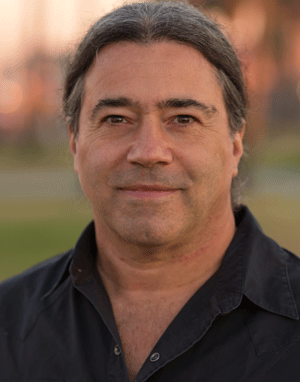 Franco spent his early years as a touring musician around the US and The Caribbean. In his late teens he moved into Boston and hired himself out as a bass player while taking writing courses at the Harvard Extension night school. He briefly attended the Berklee School of Music and studied privately under Charlie Benacos. He’s written and arranged for his own original bands and also written music for poetical theater, including Life After Motown–produced by Nobel Poet Laureate Derek Walcott, and Where The Red Road Runs, a Native American perspective of the European settlement of the Americas, which ran for six months in a Cambridge theater.
Franco spent his early years as a touring musician around the US and The Caribbean. In his late teens he moved into Boston and hired himself out as a bass player while taking writing courses at the Harvard Extension night school. He briefly attended the Berklee School of Music and studied privately under Charlie Benacos. He’s written and arranged for his own original bands and also written music for poetical theater, including Life After Motown–produced by Nobel Poet Laureate Derek Walcott, and Where The Red Road Runs, a Native American perspective of the European settlement of the Americas, which ran for six months in a Cambridge theater.
In 1995 Franco was introduced to the writings of George Pransky, Sydney Banks, and the Psychology of Mind, which later became Three Principles Psychology. He began to see the role his mind plays in his everyday life and to look there first for the source of any anxiety or stress. What he learned in this time period would later inform his contribution to “Whose Mind Is It Anyway?”
Today, Franco works in film production in Los Angeles. He collaborates with Lisa on her blog and other projects.
This is Franco and Lisa when they put on their best clothes and get their friend and photographer Silas Eyeso Brandon to take a photo in the beautiful light just before sunset. The light that makes you look very pretty. If you’re a friend of Lisa and Franco’s you will have seen this photo on their last year’s Christmas card.

FAQ
In a nutshell, how do these ideas differ from traditional psychology?
Traditional psychology is based around the idea of helping people regain their mental health by focusing on various strategies like, looking at your past, changing your thoughts, identifying problems thoughts, that kind of thing.
What we’re saying is your mental health hasn’t gone anywhere. It’s always with you. When you understand the nature of the system—what thoughts are, what the mind is and isn’t, our constant wisdom—things shift on their own. And anytime we don’t feel okay is simply a sign we’re caught up in thought.
Note, there is one branch of psychology along the same lines, called Three Principles Psychology.
How did you come to write this book together?
We are absolutely completely nuts about sharing the message that we’re okay just as we are. That we don’t have to try harder to feel better. And that the way out is to understand the system. Then it’s a case of stepping aside and letting healing and feeling good bubble up on its own. A book is a great way to do this.
It happened in two stages: The first was my (Lisa) writing a giveaway E-book, called 7 Secrets Your Mind Doesn’t Want You to Know.
It was only meant to be a 2—page giveaway, but like with most creative projects it was more a case of getting out of the way and after a couple of months I had a quirky, colorful 138—page E-book with 7 chapters and a hand drawn font.
Franco and I were traveling around New Zealand at the time. We’d met a few months earlier in Los Angeles so it was an exciting time. He was working on a music project so we’d travel and work, travel and work, in cafes, besides lakes, beside the sea.
Franco had been reading and thinking about these ideas since he was shown them as a young man. As you can imagine he was pretty tickled to discover that the girl he fancied also knew about them.
The 7 Secrets E-book was more of a hit than we’d ever imagined.
Letters came in from all around the world, from Europe to Lithuania, Africa, India, Syria, Iran, saying how the book had helped them. We heard from teachers using it in classrooms and employee assistance workers using it in the workplace. Some readers were in their teens and had no experience of self help, and others had been on the seekers path for decades. Often people who were struggling with depression, anxiety or a major life change.
The quirky, playful style combined with the level of insight hit a chord. The message was the same—this simple little book showed them a new understanding that was life changing for them. People often said that they’d read this stuff before but never really “got it.” Now they did.
As the letters kept coming and the downloads reached over 10,000 we felt there might be a place for this book and a way for it do some good.
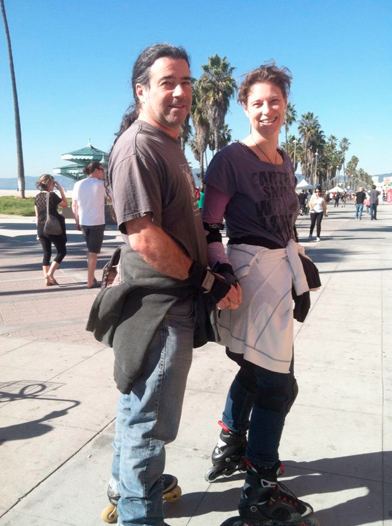
We shifted our attention from our independent projects to working together on a book proposal for an expanded version of 7 Secrets. After a while I invited Franco to join me in the writing of the book as well. We knew that together we could make something better than either one of us could do alone.
Right from the start we were united in our goal—a book that had life changing insights that would make a real difference in people’s lives, but one that looked so simple it looked like it would have taken only a few weeks to write. We even had this idea pinned to our fridge.
At one stage the book bloomed to twice it’s size, around 8000 words, so it was always a battle.
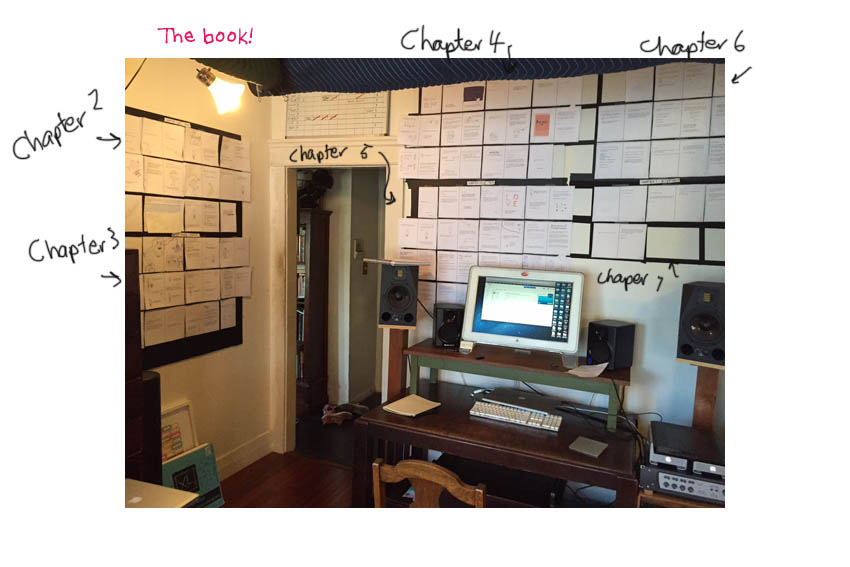
Who does the illustrations?
Both of us.
It took us a while to figure out how to illustrate together.
In the beginning we thought we’d each take a character and find continuity with our different drawing styles that way. But that didn’t happen! Instead, and at a late stage with only a few weeks before the second draft was due, we discovered how to really work together using both our strengths to jointly illustrate every picture. It was quite a ride! A sleep deprived, never leave the apartment aside from stumbling out to get the #38 from the local Chinese takeaway ride. Essentially we re-illustrated the whole book.
At one stage during all this Lisa sprained her ankle and Franco had a torn meniscus, we were both laid up with ice packs and crutches and since our laundry was in the basement neither of us were able to get down there for three weeks.
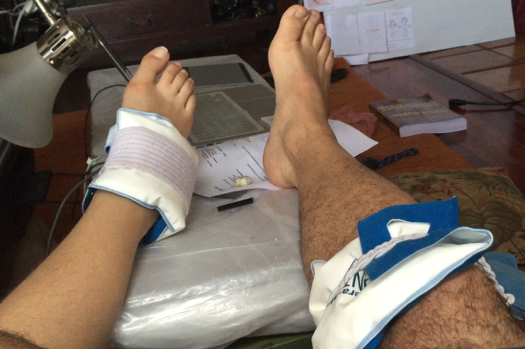
What’s up with the colors of the book?
The book is 2-color. Everything inside the cover is done with orange or purple, of varying transparencies or mixes.
Most 2-color books use black as one of the colors. But if you mix black with a color you’re only ever going to get a duller version of that color, which is why we opted for not using black at all. We wanted the book to be bright and colorful, and spent weeks picking the shades we ended up with.
Working in two-color was a whole other experience, because without going into all the details, in Photoshop you have to work in a whole different way. You can’t cut and paste and move bits of images around once you’ve colored it up. This meant that as well as taking hours to color up each plate, if we made a mistake, say the kettle lid was wrong, we couldn’t just change the lid, we had to go back to the drawing, change it there, then recolor the whole image, which could take 3 or more hours.
Aside from Lisa’s primitive illustrations on her blog, we were virgin illustrators and the learning curve was huge! In hindsight, our naïveté probably helped us as the technique we came up with, though time consuming, gave us more flexibility re color mixing.
Did anything notable or surprising happen in the writing process?
Yes!
The more we went on the more we learned to respect the other person’s way of working—because we have very different work habits. We also began to see the book had a life of its own, and we got better at trusting hunches and abandoning our preconceptions for the surprise of what was going to happen next.
Another thing was that we began to see the power of illustration to tell a story. In our contract negotiations we’d negotiated down from 70 drawings to 40-60 but after seeing how whole pages of text could be replaced by a single drawing we ended up doing over 160.
A final thing worth mentioning is we noticed that everything we were writing about, each mind trick, was being played out in the process of working so intensely on a project together. The irony of working on the control chapter while one of us (probably Lisa) was being controlling was not lost on us.
People often ask us if this experience was tough on our marriage. The honest answer is that it was a bit tricky at first, but once we got the hang of things, it brought us even closer together. We have huge respect for the other person’s abilities, and it was a dream to be able to work so intensely on a project we’re both so passionate about We are enormously grateful to have had the opportunity to do this.
